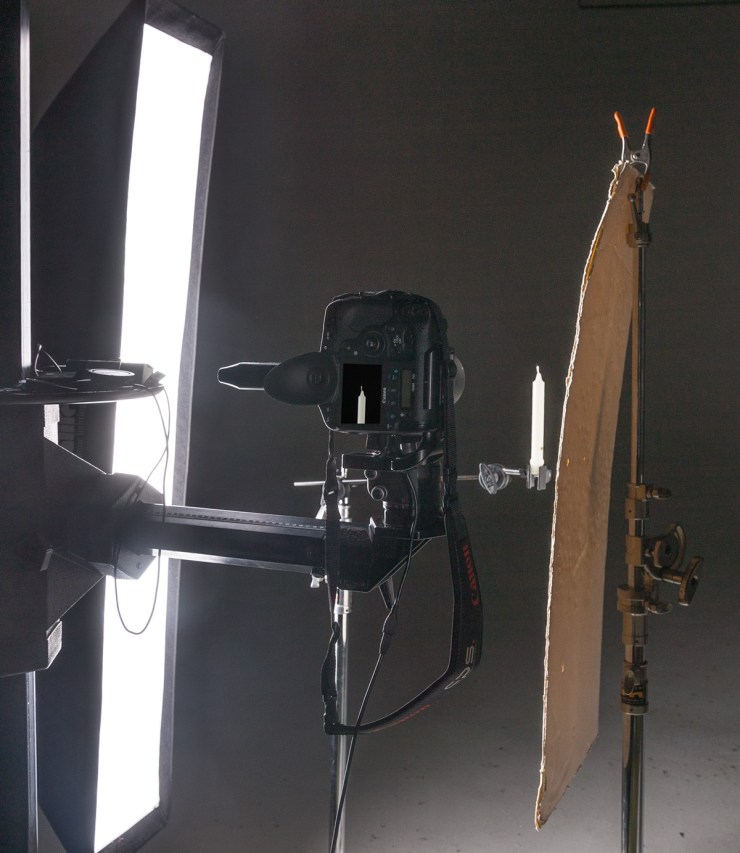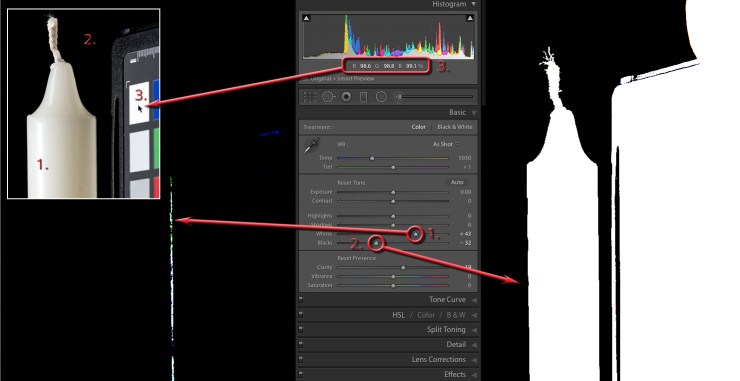Let’s photograph a lit candle and not. It’s simple right? Well, maybe …
The setup
When I start to photograph anything, I ask myself “What is it?” By that I mean describe its properties. Looking at the candle, I see it’s round. No. Make that cylindrical. It’s reflective. It has texture, well the wick has it anyway.
The properties tell me what the light wants to be. Reflective cylinders must be defined with a highlight running the length of it to reveal the roundness. How important is the texture of the wick compared to the shape of the candle? Not much. So the light has to be long though not necessarily wide.
I placed a Dynalite 12″ by 71″ strip bank over a Dynalite Studio Electronic Flash head to the left of the candle clamped to a light stand using Matthews Mini Grip gear. A piece of white foam core on the left filled in the shadow. The background is to be black. I read the electronic flash with the incident dome of my Sekonic L-758DR pointed at the strip bank.
The exposure is f/8.0, ISO: 100 @ 1/125th. The wall in the background in my studio is white and about twenty feet behind the candle. With the light this close to the candle the background will be black. If your shooting area is tighter space-wise, hang a piece of black velvet cloth to make the background black. It only needs three to five feet of space from the candle to go totally black.

Camera Raw / Develop
The next part can be done in Lightroom’s Develop module or with Camera Raw in either Bridge or Photoshop. I made an exposure that included an X-Rite ColorChecker Passport to set the color balance and refine the exposure.
Adjust the White slider
Hold down the Option (Win: Alt) key then move the White slider (1.) to the right until the highlight on the candle turns white. White indicates that all three channels, Red, Green & Blue, are at 100% (Lightroom) or 255 (Camera Raw .)
Next, use the Black slider
Again, holding down the Option (Win: Alt) key pull the Black slider to the left until the entire background becomes black. Black tells us that the three channels are 0% (Lightroom) or 0 (Camera Raw.)
Read the ColorChecker’s white patch
Move the cursor over the white patch on the ColorChecker Passport. Under the Histogram, the numbers will be close to if not 100% (Lightroom) or 255 (Camera Raw.)

Photographing fire
Light the candle. Turn the modeling lights and all other lights in the studio off. If you are shooting in a room with windows, wait until dark then pull the drapes to get the room totally black. The only ambient light in the room is the burning candle. Be sure to turn off the HVAC and ceiling fans to prevent the flame from flickering.
Now take a reflected light reading of the center of the flame if you have a spot meter. If not hold the meter close to the flame or use the spot meter in your camera. My exposure for the flame is 1/60th, f/8.0 ISO: 100. Make the photograph.
Lights out ~ the flash too …
By now you’ve probably figured out that photographing candles IRL (In Real Life) isn’t practical. Instead, let’s make a set of flames that can be used to light any candle in post-production. I shot a set starting from 1 second through 1/500th of a second.
Blow out the candle
That’s it. Now you’ve made a flame library to use to light candles using Photoshop and more. How? Stay tuned.
Tell your story with the second annual Visual Storytelling Conference!
Experience four days of interactive, online training sessions featuring a range of educational content with experienced photographers and content creators. This free event kicks off with a series of technical boot camps to build essential skills, followed by live, online sessions on photography, video, business and social media. Join live from March 10-13, 2022!
